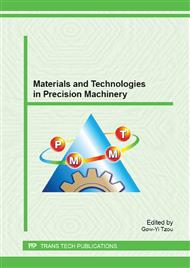[1]
Saotome, Y. and H. Iwazaki, Superplastic backward microextrusion of microparts for micro-electro-mechanical systems. Journal of Materials Processing Technology, 119(1): pp.307-311. (2001).
DOI: 10.1016/s0924-0136(01)00957-8
Google Scholar
[2]
Kang, D. -H. and T. -W. Kim, Mechanical behavior and microstructural evolution of commercially pure titanium in enhanced multi-pass equal channel angular pressing and cold extrusion. Materials & Design, 31: p. S54-S60. (2010).
DOI: 10.1016/j.matdes.2010.01.004
Google Scholar
[3]
Zhang, X., et al., Atomistic simulations of solid solution strengthening in Ni-based superalloy. Computational Materials Science, 68: pp.132-137. (2013).
DOI: 10.1016/j.commatsci.2012.10.002
Google Scholar
[4]
Chao, J. s. and J.L. GonzC!lez-Carrasco, On the differences of the 475B0 C age hardening between as-hot rolled and recrystallised MA956 alloy. Scripta materialia, 50(12): pp.1457-1460. (2004).
DOI: 10.1016/j.scriptamat.2004.03.006
Google Scholar
[5]
Galindo-Nava, E. and P. Rivera-DC-az-del-Castillo, Thermostastitical modelling of deformation twinning in HCP metals. International Journal of Plasticity, 55: pp.25-42. (2014).
DOI: 10.1016/j.ijplas.2013.09.006
Google Scholar
[6]
Furukawa, M., et al., Microhardness measurements and the Hall-Petch relationship in an Al Mg alloy with submicrometer grain size. Acta Materialia, 44(11): pp.4619-4629. (1996).
DOI: 10.1016/1359-6454(96)00105-x
Google Scholar
[7]
Valiev, R.Z., R.K. Islamgaliev, and I.V. Alexandrov, Bulk nanostructured materials from severe plastic deformation. Progress in materials science, 45(2): pp.103-189. (2000).
DOI: 10.1016/s0079-6425(99)00007-9
Google Scholar
[8]
ohidi, A., M. Ketabchi, and A. Hasannia, Nanograined Ti–Nb microalloy steel achieved by Accumulative Roll Bonding (ARB) process. Materials Science and Engineering: A, 577: pp.43-47. (2013).
DOI: 10.1016/j.msea.2013.04.025
Google Scholar
[9]
Li, S., et al., Finite element analysis of the plastic deformation zone and working load in equal channel angular extrusion. Materials Science and Engineering: A, 382(1): pp.217-236. (2004).
DOI: 10.1016/j.msea.2004.04.067
Google Scholar
[10]
Huang, J., et al., Microstructures and dislocation configurations in nanostructured Cu processed by repetitive corrugation and straightening. Acta Materialia, 49(9): pp.1497-1505. (2001).
DOI: 10.1016/s1359-6454(01)00069-6
Google Scholar
[11]
Zhilyaev, A.P. and T.G. Langdon, Using high-pressure torsion for metal processing: Fundamentals and applications. Progress in Materials Science, 53(6): pp.893-979. (2008).
DOI: 10.1016/j.pmatsci.2008.03.002
Google Scholar
[12]
Lin, J. -B., et al., Microstructure and texture characteristics of ZK60 Mg alloy processed by cyclic extrusion and compression. Transactions of Nonferrous Metals Society of China, 20(11): pp.2081-2085. (2010).
DOI: 10.1016/s1003-6326(09)60421-0
Google Scholar
[13]
Guo, W., et al., Microstructure and mechanical properties of AZ31 magnesium alloy processed by cyclic closed-die forging. Journal of Alloys and Compounds, 558: pp.164-171. (2013).
DOI: 10.1016/j.jallcom.2013.01.035
Google Scholar
[14]
Furukawa, M., et al., The shearing characteristics associated with equal-channel angular pressing. Materials Science and Engineering: A, 257(2): pp.328-332. (1998).
DOI: 10.1016/s0921-5093(98)00750-3
Google Scholar
[15]
ASTM, 1989, Annual Book of ASTM Standards: Metals Test Methods & Analytical Procedures, Press: American Society for Testing & Materials, 639-645.
Google Scholar
[16]
Balasundar, I., M.S. Rao, and T. Raghu, Equal channel angular pressing die to extrude a variety of materials. Materials & Design, 30(4): pp.1050-1059. (2009).
DOI: 10.1016/j.matdes.2008.06.057
Google Scholar
[17]
Greger, M., M. Widomská, and J. Maceček. STRUCTURE AND MECHANICAL PROPERTIES ULTRA-FINE GRAINED TITANIUM. in 13th International Research Conference TMT. (2009).
Google Scholar
[18]
ASTM, 1989, Annual Book of ASTM Standards: Metallography, nondestructive testing, Press: American Society for Testing & Materials, 121-155.
Google Scholar
[19]
ASTM E92-82 (Reapproved 1992), Standard Test Method for Vickers Hardness of Metallic Materials, 1997 Ed, Vol. 0301, pp.207-215.
Google Scholar


